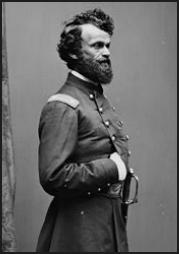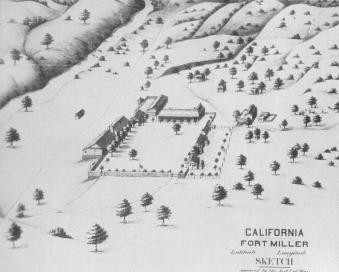Yosemite > Library >
Moore >
Reports from Lt. Tredwell Moore to the Pacific Division on the Mariposa Indian War of 1852.
 These reports give a slightly different account on the Mariposa Indian War of 1852
from that of
Lafayette H. Bunnell in his book
Discovery of the Yosemite.
These reports were found by Thomas C. Fletcher among
U.S. Army correspondence in the National Archives, Washington, D.C.
They are reproduced in his book
Paiute, Prospector, Pioneer: The Bodie-Mono Lake Area in the Nineteenth Century
(Lee Vining, California: Artemisia Press, 1987).
ISBN 0-932347-03-7, LCCN 87-70792.
This book is out-of-print but can be found in used bookstores.
The differences between Dr. Bunnell’s and Lt. Moore’s accounts,
and reconstruction of events from both, are detailed in Chapter 2
of Fletcher’s book, along with the full reports of Lt. Moore in the Appendix,
which reproduced in full below.
After an extensive search by Fletcher,
no more reports have been found.
These reports give a slightly different account on the Mariposa Indian War of 1852
from that of
Lafayette H. Bunnell in his book
Discovery of the Yosemite.
These reports were found by Thomas C. Fletcher among
U.S. Army correspondence in the National Archives, Washington, D.C.
They are reproduced in his book
Paiute, Prospector, Pioneer: The Bodie-Mono Lake Area in the Nineteenth Century
(Lee Vining, California: Artemisia Press, 1987).
ISBN 0-932347-03-7, LCCN 87-70792.
This book is out-of-print but can be found in used bookstores.
The differences between Dr. Bunnell’s and Lt. Moore’s accounts,
and reconstruction of events from both, are detailed in Chapter 2
of Fletcher’s book, along with the full reports of Lt. Moore in the Appendix,
which reproduced in full below.
After an extensive search by Fletcher,
no more reports have been found.
Seymour Tredwell Moore was born 1827 in Ohio.
He graduated from West Point in 1847.
He served in California in the 1850s
protecting miners from the American Indians.
Tredwell Moore established Fort Miller to help do so.
During the Civil War, he served in Nevada keeping insurrections down from
Confederate sympathizers.
He was breveted to brigadier general in 1865.
He died in 1876.

Fort Miller
|
Report of June 12, 1852
The first report was from Fort Miller,
which Lt. Moore commanded.
Ft. Miller was located on the San Joaquin River near present-day Fresno
and was established in 1851 to protect the gold miners and other settlers.
Ft. Miller is now underneath Millerton Reservoir,
northwest of Fresno, California.
Hd Qrs Fort Miller, Cal.
June l2th, 1852
Sirs
Information was received at this post a few days since, that the Indians on
the head
waters of the Merced had made an attack on eight white men who were
"prospecting"
the south fork of that river. Three of the whites were killed, and two were
severely
wounded. A party of miners, after the news came in, went in pursuit of the
Indians.
They did not succeed in overtaking them but have I believe recovered the
bodies of the
killed. The Indians who committed the murders belong to the Yo-sem-i-ties,
of whom
complaint was made to the Genl. Comds. last winter. They have committed
many robberies,
but have until this last act, refrained from murder. I will start
in pursuit of them
on Monday next, and endeavor not only to punish the Indians who were
engaged in committing
the murder, but also to remove the tribe to the reservation set
aside for them by
the commissioners last year. Qr. Masters funds will be necessary to carry
on the Expedition.
Enclosed you will find requisitions for funds and stores, which please submit to the
General Comds. as early as convenient.
Capt. E. D. Townsend
Ass. Adj. Genl.
Benicia, Cal.
|
I am sir very
respect-
fully
Your obt Srvt
T Moore
|
|
Report of July 8, 1852
According to Fletcher,
"Camp Steele" was probably located on the old Mono Trail
in Little Yosemite Valley, or perhaps
southwest near Westfall Meadows.
Also, Fletcher believes the "main ridge of the Sierra"
refers to the Cathedral Range, not the Sierra crest.
Head Quarters Camp Steele
Near the Head Waters of the Merced
July 8th, 1852
Sir
I have the honor to report that, I arrived at my present encampment on the Head
Waters of the Merced on the 20th of June, immediately on my arrival scouting parties
were sent to scour the country in all directions. Many deserted "Rancherias" were
found, but no Indians. The friendly Indians we had with us as guides are of the opinion
that the entire tribe had crossed the Sierras. Major Savage with a party of Indians struck
a fresh trail heading from the valley towards the head waters of the San Joaquin, his
provisions giving out he was obliged to return. On the lst I took with me a party of
twelve men and taking Major Savage’s trail soon came to a heavy trail. This we continued
to follow. And on the morning of the 4th crossed the main ridge of the Sierra. I
encamped about noon and sending out scouts I received information that there was a
"Rancheria" some four miles distant, by dividing my party I was enabled to take them so
completely by surprise that before they were able to move they were entirely surrounded.
Twenty-one prisoners were taken—six men, the remainder women and
children—one of the prisoners acknowledged that they saw the murders of the whites on
the Merced, but denied having participated in it. A number of trinkets together with
some clothing was found which fully implicated their participation in the division of the
murdered men’s property, if not in the murder. The men I then ordered to be shot which
was done on the morning of the 5th. From the women taken I have learned that it was a
general thing and that nearly the entire tribe was present at the murder. Lieut. McLean
started for Yo Semity Valley on the 1st with ten men with instructions to destroy the
"Rancherias" and provisions there, he succeeded in finding a large quantity of acorns
which were destroyed. One of his men (Riley) was severely wounded receiving two
arrow shots on the night of the 4th while on post as sentinel. Lieut. McLean arrived this
morning, having accomplished the destruction of as much property and provisions as
could be found. Riley the wounded man died last night. Mr. Crosby will hand you requisition
which please submit to the Genl. Commanding at your earliest opportunity.
Capt. E. D. Townsend
Ass. Adjt. Genl.
Pacific Division
San Francisco, Cala.
|
I am Sir
Very Respectfully
Your obdt Servt.
T. Moore
1st Lt. Infantry
Comdg. Expedition
|
|
Report of July 9, 1852
Hd. Qrs. Camp Steele
July 9th, 1852
Sir
From information received from the Indian women taken a few days since, I have
determined to follow the Yosemities across the Sierras, into the Mono country. The Yo
semitis are on friendly terms with the Monos and have fled to this country thinking that
the whites will not follow them across the snow. A few families are yet scattered in the
vallies high up in the mountains, but are making their way as rapidly as possible to the
Mono territory. The squad taken on the 4th was one of these detached parties. The Indians
inform me that mules can be taken across the mountains without much
difficulty—In
connection with this I would state that my command is so small, that I cannot with
prudence detach men from it to guard the pack train. This up to the present, has not
been necessary, but my farther movement in the mountains will require that the train
have a small escort for the safe transmission of supplies. I would respectfully suggest
that a small detachment of dragoons be sent to me for that purpose—I would also state
that the necessity of detaching two and three men as scouts, without other anus than muskets,
has led me to think that a few six shooters would be of service for parties of this nature.
Enclosed I transmit a requisition for ten which I hope will meet the approbation of
the Genl Comdg.
Capt. E. D. Townsend
Ass. Adj. Genl.
Pacific Division
San Francisco, Cal.
|
I am Sir very
respectfully
Your
obt servt.
T. Moore
Lt. In’try
|
|
Digitized by Dan Anderson, 2004.
These files may be used for any non-commercial purpose,
provided this notice is left intact.
—Dan Anderson, www.yosemite.ca.us
http://www.yosemite.ca.us/library/reports_from_lt_tredwell_moore/
 These reports give a slightly different account on the Mariposa Indian War of 1852
from that of
Lafayette H. Bunnell in his book
Discovery of the Yosemite.
These reports were found by Thomas C. Fletcher among
U.S. Army correspondence in the National Archives, Washington, D.C.
They are reproduced in his book
Paiute, Prospector, Pioneer: The Bodie-Mono Lake Area in the Nineteenth Century
(Lee Vining, California: Artemisia Press, 1987).
ISBN 0-932347-03-7, LCCN 87-70792.
This book is out-of-print but can be found in used bookstores.
The differences between Dr. Bunnell’s and Lt. Moore’s accounts,
and reconstruction of events from both, are detailed in Chapter 2
of Fletcher’s book, along with the full reports of Lt. Moore in the Appendix,
which reproduced in full below.
After an extensive search by Fletcher,
no more reports have been found.
These reports give a slightly different account on the Mariposa Indian War of 1852
from that of
Lafayette H. Bunnell in his book
Discovery of the Yosemite.
These reports were found by Thomas C. Fletcher among
U.S. Army correspondence in the National Archives, Washington, D.C.
They are reproduced in his book
Paiute, Prospector, Pioneer: The Bodie-Mono Lake Area in the Nineteenth Century
(Lee Vining, California: Artemisia Press, 1987).
ISBN 0-932347-03-7, LCCN 87-70792.
This book is out-of-print but can be found in used bookstores.
The differences between Dr. Bunnell’s and Lt. Moore’s accounts,
and reconstruction of events from both, are detailed in Chapter 2
of Fletcher’s book, along with the full reports of Lt. Moore in the Appendix,
which reproduced in full below.
After an extensive search by Fletcher,
no more reports have been found.
